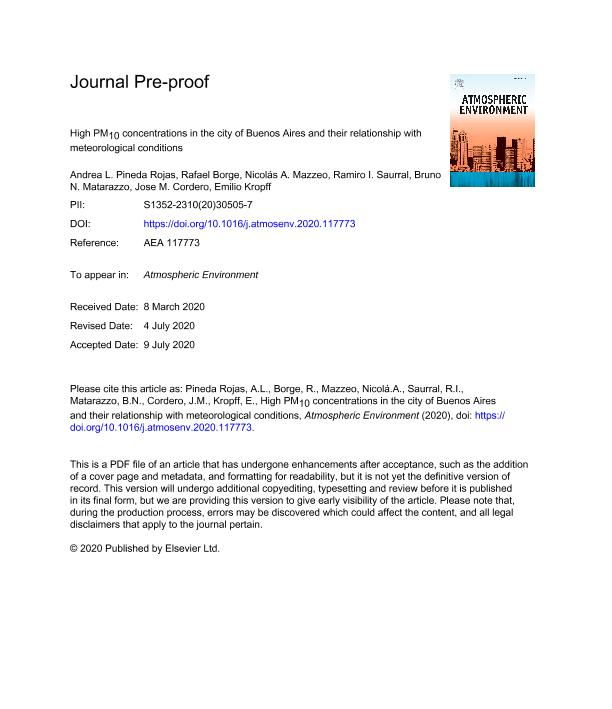Mostrar el registro sencillo del ítem
dc.contributor.author
Pineda Rojas, Andrea Laura

dc.contributor.author
Borge, Rafael
dc.contributor.author
Mazzeo, Nicolás A.
dc.contributor.author
Saurral, Ramiro Ignacio

dc.contributor.author
Matarazzo, Bruno Nicolas

dc.contributor.author
Cordero, Jose M.
dc.contributor.author
Kropff, Emilio

dc.date.available
2021-10-14T19:46:31Z
dc.date.issued
2020-11
dc.identifier.citation
Pineda Rojas, Andrea Laura; Borge, Rafael; Mazzeo, Nicolás A.; Saurral, Ramiro Ignacio; Matarazzo, Bruno Nicolas; et al.; High PM10 concentrations in the city of Buenos Aires and their relationship with meteorological conditions; Pergamon-Elsevier Science Ltd; Atmospheric Environment; 241; 11-2020; 1-37; 117773
dc.identifier.issn
1352-2310
dc.identifier.uri
http://hdl.handle.net/11336/143678
dc.description.abstract
In this work, the first long-term (eight years) record of hourly concentrations of carbon monoxide (CO), nitrogen dioxide (NO2) and particulate matter with diameter less than 10 μm (PM10) from three sites in the city of Buenos Aires is analysed. Considering the short-term guidelines suggested by the WHO, the daily mean PM10 concentrations present a relatively large number of exceedances at the three sites. Different statistical techniques are combined to study the relationship between these relatively high PM10 concentrations and relevant surface meteorological variables. For all pollutants and sites, wind speed shows the largest differences between the lowest and highest concentration quartiles. To further explore its role on daily mean PM10 concentration, a k-means algorithm is applied, grouping days with similar surface 1h-wind sequences. Five wind sequence clusters are found, presenting distinctive air quality data features. Two clusters (1 and 2) show that PM10 exceedances occurring with winds entering the city from the river represent between 10 and 21% of total events at the three sites. The frequency of exceedance under these conditions decreases with the distance to the coast. For cluster 1, the hourly PM10 concentration profile and its associated daily wind sequence suggest an important contribution to exceedance events from the city's southernmost power plant. Two clusters (3 and 4), exhibiting continental winds, account for 49–59% of the exceedances and co-occur with relatively drier air conditions. The correlation between CO and PM10 for days belonging to cluster 3 supports the hypothesis of a potential remote or distributed source contribution with SW winds. For cluster 4, differences among sites in the number of events under NNW winds suggest an important contribution from the city's widest avenue to the PM10 levels at the most coastal site. A large contribution coming from urban sources is also indicated for these winds. Finally, cluster 5, exhibiting low wind speed sequences, accounts for 23–33% of the exceedances at the three sites. The average PM10 concentration increases with persistence of this cluster, which could be a driver for exceedances. These results contribute to show the importance of simple methods such as clustering analysis to obtain insights into air quality features such as exceedances and their potential drivers. They also suggest that further efforts in monitoring, modelling and emission estimates may help to better understand local, urban and regional source contributions to these events in the city of Buenos Aires.
dc.format
application/pdf
dc.language.iso
eng
dc.publisher
Pergamon-Elsevier Science Ltd

dc.rights
info:eu-repo/semantics/embargoedAccess
dc.rights.uri
https://creativecommons.org/licenses/by-nc-nd/2.5/ar/
dc.subject
AIR QUALITY DATA
dc.subject
BUENOS AIRES
dc.subject
EXCEEDANCE CONDITIONS
dc.subject
METEOROLOGICAL DATA
dc.subject.classification
Meteorología y Ciencias Atmosféricas

dc.subject.classification
Ciencias de la Tierra y relacionadas con el Medio Ambiente

dc.subject.classification
CIENCIAS NATURALES Y EXACTAS

dc.title
High PM10 concentrations in the city of Buenos Aires and their relationship with meteorological conditions
dc.type
info:eu-repo/semantics/article
dc.type
info:ar-repo/semantics/artículo
dc.type
info:eu-repo/semantics/publishedVersion
dc.date.updated
2021-09-07T18:13:04Z
dc.journal.volume
241
dc.journal.pagination
1-37; 117773
dc.journal.pais
Estados Unidos

dc.description.fil
Fil: Pineda Rojas, Andrea Laura. Consejo Nacional de Investigaciones Científicas y Técnicas. Oficina de Coordinación Administrativa Ciudad Universitaria. Centro de Investigaciones del Mar y la Atmósfera. Universidad de Buenos Aires. Facultad de Ciencias Exactas y Naturales. Centro de Investigaciones del Mar y la Atmósfera; Argentina
dc.description.fil
Fil: Borge, Rafael. Universidad Politécnica de Madrid; España
dc.description.fil
Fil: Mazzeo, Nicolás A.. Universidad Tecnológica Nacional. Facultad Regional Avellaneda; Argentina
dc.description.fil
Fil: Saurral, Ramiro Ignacio. Consejo Nacional de Investigaciones Científicas y Técnicas. Oficina de Coordinación Administrativa Ciudad Universitaria. Centro de Investigaciones del Mar y la Atmósfera. Universidad de Buenos Aires. Facultad de Ciencias Exactas y Naturales. Centro de Investigaciones del Mar y la Atmósfera; Argentina
dc.description.fil
Fil: Matarazzo, Bruno Nicolas. Universidad de Buenos Aires. Facultad de Ciencias Exactas y Naturales. Departamento de Ciencias de la Atmósfera y los Océanos; Argentina
dc.description.fil
Fil: Cordero, Jose M.. Universidad Politécnica de Madrid; España
dc.description.fil
Fil: Kropff, Emilio. Consejo Nacional de Investigaciones Científicas y Técnicas. Oficina de Coordinación Administrativa Parque Centenario. Instituto de Investigaciones Bioquímicas de Buenos Aires. Fundación Instituto Leloir. Instituto de Investigaciones Bioquímicas de Buenos Aires; Argentina
dc.journal.title
Atmospheric Environment

dc.rights.embargoDate
2021-12-01
dc.relation.alternativeid
info:eu-repo/semantics/altIdentifier/url/https://www.sciencedirect.com/science/article/abs/pii/S1352231020305057
dc.relation.alternativeid
info:eu-repo/semantics/altIdentifier/doi/http://dx.doi.org/10.1016/j.atmosenv.2020.117773
Archivos asociados
